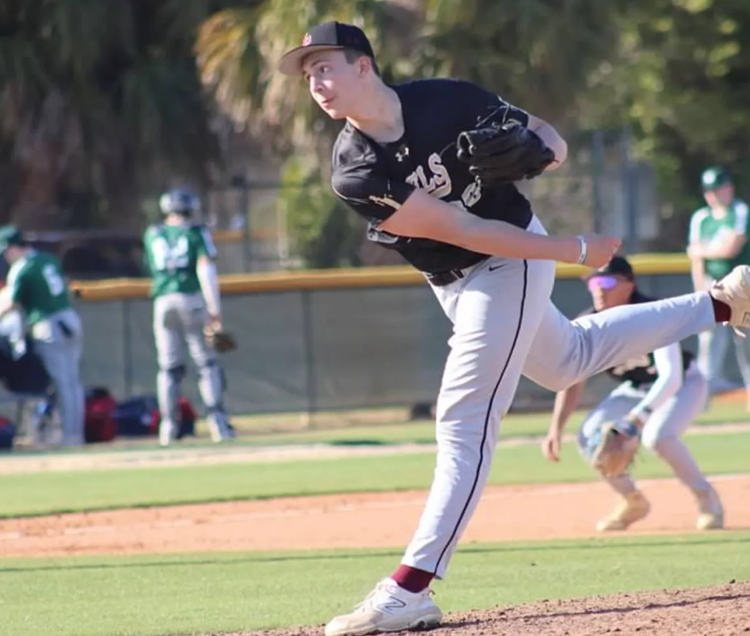
Iona Prep HS and University of Maryland commit Shane Jelenevsky joined us last summer to get a head start on his training for spring season of this year. At the time, Shane was looking to add velocity to his heater, improve his arsenal, while optimizing his mechanics this offseason. By this past spring, Shane had added 4 mph on his fastball going from 88 mph to 92 mph. And more recently he was selected as Westchester / Putnam Pitcher of the Year.
How did he do it?
RPP’s off-season high school programs begin in late August / early September and end in early March. Shane started the off-season with a comprehensive physical and mechanical evaluation:
-
- Physical Assessment – Covers a number of important topics, including (a) lower and upper half mobility (b) lower and upper half strength (c) lower and upper half power (d) speed – 30-yard dash, (e) lower and upper half elasticity – (f) decel metrics, (g) body fat % and lean mass ratios and finally a force-velocity evaluation profile.
- Mechanical Assessment – Represents a complete analysis and reporting of the athlete’s delivery and broken down into three specific areas kinematically. These include (a) arm and shoulder, (b) trunk movement and (c) the lower half.
- Pitch Arsenal – Represents a thorough analysis of the pitcher’s arsenal, pitch-movement profile for potential improvements in movement or an expansion of the overall repertoire.
By the time an athlete has completed our evaluation, we have an excellent idea of what his strengths are and which weaknesses we should pursue to optimize performance. There is NO better blueprint.
Physical Assessment
Body Composition
Below is a summary of Shane’s height, weight, and body fat % from his assessment last summer. Needless to say, at 6’6” 228lbs, Shane has a very large frame with long levers that play to his advantage on the mound. Increasing his lean body mass by putting on 10 lbs. of muscle in exchange for body fat will give us 228 lbs. with a bigger engine to move his frame.
-
- Height – 78″
- Weight – 228 lbs.
- Ratio – 2.92 (desired range of 2.5-3.0)
- Body Fat – 22%
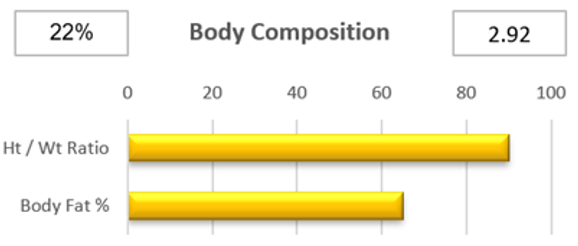
Upper and Lower Half Mobility
The movement screening portion of the assessment is essential in identifying mobility and / or stability issues that may hinder the athlete’s ability to get into optimal positions throughout the delivery. In most cases, the issues that are presented in this portion of the assessment will be visible when we are evaluating the athlete’s mechanics in the video analysis portion of the assessment.
After completing Shane’s table assessment, we found that he had limitations in his right hip external rotation. This could compromise the way he loads his back leg as he descends down the mound. We also found limited shoulder range of motion (ROM) in both internal and external rotation, which could impact not only the way his arm both accelerates and decelerates from foot plant through release but contributing to added valgus stress on his elbow.

Upper and Lower Body Strength
After completion of the movement screen, we then moved on to our strength and power testing to help give us more information about the type of athlete we were dealing with. Higher gains in these two categories help to create not only a higher ceiling, but an overall more athletic body.
The following is a summary of Shane’s estimated 1RM Metrics in the weight room. As you can see, Shane’s strength needed improvement in “the big 3” from what we consider strong enough…
-
- Trap Bar Deadlift: 342 lbs. (vs. optimal 2.5x B.W. = 513 lbs.)
- Single Leg Squat: 70 lbs. (vs. optimal @ 55% B.W. = 125 lbs.)
- Bench Press: 143 lbs. (vs. optimal 1.25x B.W. = 285 lbs.)
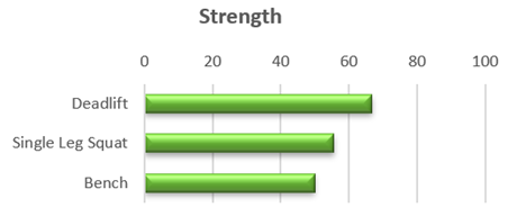
Lower and Upper Half Power
Power = Force X Velocity
Power is all about how quickly we can produce Force (strength). In baseball, you need to be both strong and powerful in the lower and upper halves.
Lower Half – With respect to power, the first test we complete is a Counter Movement Jump (CMJ). This jump is performed to test the athlete’s ability to utilize their Stretch Shortening Cycle and relates to the velocity portion of the power equation and ultimately gives us the athletes Force-Velocity profile.
The second test, Squat Jump, is performed to test the athlete’s ability to use muscular force and relates to the force side of the power equation and Force-Velocity Curve.
Shane’s lower half power testing was exceptional. He is a very springy and quick twitch athlete which is one of his strong suits that we see here in his lower half testing.
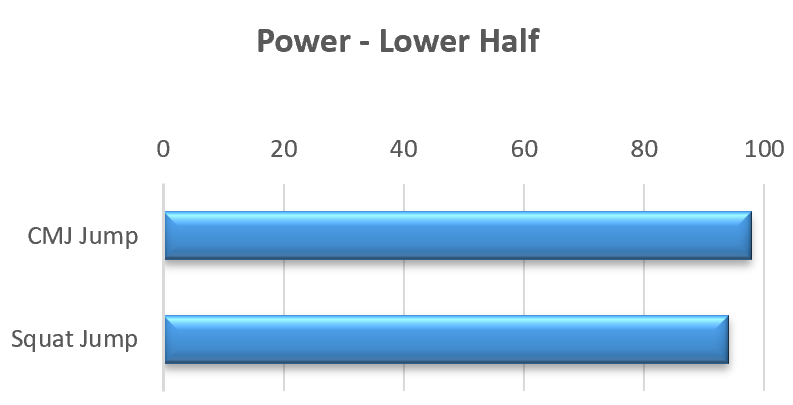
Upper Half – We test upper half rotational power on a Proteus Motion machine, utilizing two different tests:
-
- Trunk Rotation – Similar to the squat jump this involves no “pre-stretch”
- Plyo Trunk Rotation – Same movement with a “pre-stretch”
As seen below, Shane demonstrated both inefficient power production as well as Elasticity in the frontal and transverse planes which required further development of his upper half.
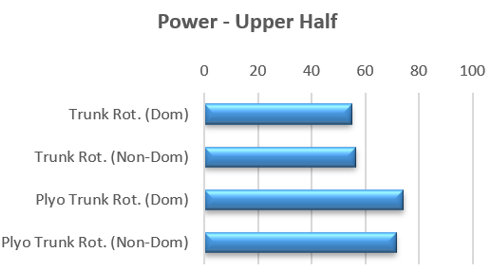
Decel
This test looks at the ability of the athlete’s lead leg to hit the brakes immediately at foot plant and in turn transfer force back up the kinetic chain to use during the throw, or in the case of the test, how quickly they can land on one leg and concentrically turn that force the other way with a jump. Jump height and contact time give us what is known as a “Reactive Strength Index” (RSI).
Having the ability to decelerate is one of the most important attributes that a pitcher needs to efficiently transfer force up the chain. Shane’s assessment highlighted this as an area of improvement. Based on his “Front Leg RSI” results in the assessment, Shane’s plyometric ability was a Phase 2. This means that he was able to stabilize quickly but lacked the necessary speed from a plyometric standpoint. This, mostly due to Shane’s elasticity score (see above).

Pitching Mechanics
The pitching mechanics analysis involves analysis of dozens of possible disconnects in the delivery which are then summarized into a summary report. In Shane’s case we also had the benefit of our in-house motion capture report. The following is a summary of the summary.
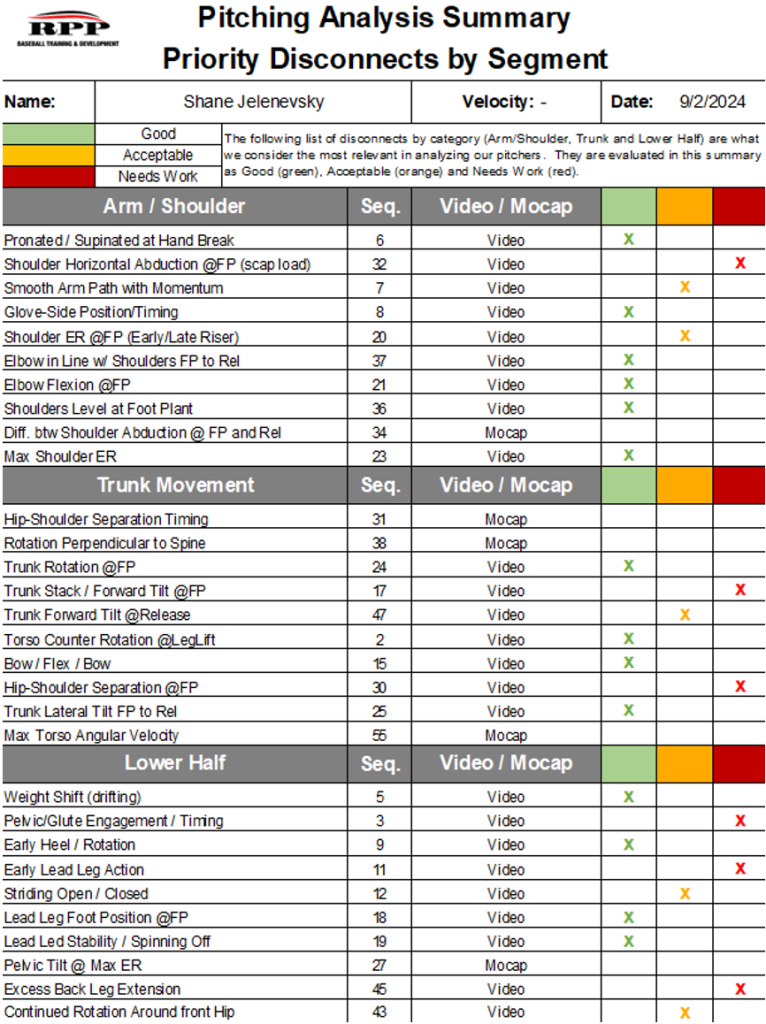
It’s important to prioritize when addressing too many mechanical issues at a time. We identified several disconnects when analyzing Shane’s delivery (see above). We then chose what we believed to be the 6 biggest disconnects we needed to address. Below is a summary and description of each:
Arm/Shoulder
-
- Shoulder Horizontal Abduction @FP (scap load): Shoulder Horizontal Abduction at Ball Release is an athlete’s ability to get their arm up on time through release. Not accessing the scap puts a ton of pressure on the humeral head and creates a pushy arm action which could be caused by the shoulder range of motion limitations found on the table portion of the assessment.
Trunk Movement
-
- Trunk Stack/Forward Tilt at Foot Plant: This is the ability to keep the pelvis and upper body stacked from the beginning of the linear move all the way into FP. A stable and braced trunk allows a pitcher to store energy longer before he rotates violently into release.
- Hip Shoulder-Separation @ FP: Ability to rotate the hips into landing while keeping torso closed and this ideally occurs at or slightly after foot plant. This is a key factor in helping to create torque as well as a harder throw with less effort.
Lower Half
-
- Pelvic/Glute Engagement/Timing: We categorize this by inefficient weight distribution on the back leg/foot with a hinge at the hips. Maintaining a stacked trunk going into FP to avoid getting into extension and jumping out of the backside is key to delivering a higher velocity strike
- Early Lead Leg Action: Front leg opening into ER before back leg snaps down to initiate rotation.
- Excess Back Leg Extension: Back foot comes off the ground prior to release and /or front knee buckles or leaks forward.
Addressing mechanical disconnects is often addressed by work both in the weight room and specific drill sets we assign the athlete to be performed on a daily basis. The following plyo drills were assigned to help him with improved movement down the mound:
-
- Half Kneeling Throws: Used to help tap into rotation during delivery by eliminating the lower half from the throw and focus on hip-shoulder separation.
-
- Standing Go Call: Similar feel to the Half Kneeling Throw just now performing it bilaterally focusing on the arm flowing naturally into the same plane of rotation as the trunk.
-
- Step Back Drill: Used to improve shifting COM (Drifting) and front foot position @ FP.
-
- Hook’em Drill: Used to help glute engagement in the loading phase of the delivery.
Pitching Arsenal
Shane came in with a 4SFB, SNK, CH, CB. His CH was his best pitch but because he was able to throw it at a higher velocity, the lowest hanging fruit to remove from the arsenal was the SNK. We figured by leveraging his heater at the top of the zone and changeups down. The next step was now creating a breaking ball that he could differentiate from the CB both movement and velocity wise.
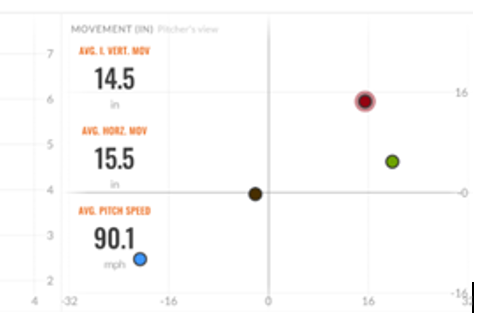
The one pitch that we added to his arsenal that we used to expand the zone and change levels was his Cutter. We wanted to add this to compliment his bigger breaking ball because he does showcase the ability to supinate well even though he is a low slot pronator. Providing him with the proper grip and cues to stay committed to it like a fastball allowed him to create late break while still throwing it in the high 78-82 mph range.
Shane now has a refined his arsenal that features an 88-92 mph fastball, changeup, cutter, and curveball.
Spring Season
By this past spring, Shane had added 4 mph on his fastball going from 88 mph to 92 mph. Outside of winning a state title this year, Shane absolutely dominated on the mound. In 76.2 innings he pitched two back-to-back no-hitters, an 11-0 record and 112 k’s with a 0.60 ERA. It’s safe to say that he was lights out this season.
And more recently he was selected as Westchester / Putnam Pitcher of the Year.
Congrats Shane! Well done!!
By Niko Leontarakis (Director of Pitching)
You live too far to train with us in-house at RPP? You can now train with us on a REMOTE basis.


